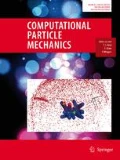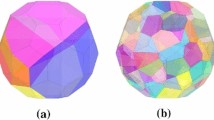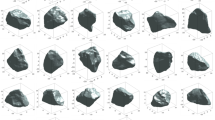Abstract
In this paper, we use a 2D bond-based peridynamic model to investigate the strength of disk-shaped particles including pre-cracks. We use a diametral (or Brazilian) test to break the particles. For the flawless particles, we find that the stress distribution compares well with an analytical model accounting for the size of the contact zone, and the particle stiffness tends linearly to a well-defined value for increasingly resolved meshing. We then introduce cracks, which are numerically defined by reducing the Young modulus of the bonds crossing linear segments. We consider in detail the effect of a single vertical crack on the yield stress as a function of its position. We also consider a randomly distributed population of cracks with sizes generated from a Gaussian size distribution. For a parametric study with a hundred particles, we found a probability of failure that is well fit by a Weibull law. Finally, using an image analysis algorithm, we investigate the statistics of cracks and the resulting fragments.


















Similar content being viewed by others
References
Song B, Rough S, Wilson D (2007) Effects of drying technique on extrusion-spheronisation granules and tablet properties. Int J Pharm 332(1–2):38
Fichtner F, Rasmuson Å, Alderborn G (2005) Particle size distribution and evolution in tablet structure during and after compaction. Int J Pharm 292(1–2):211
Affes R, Delenne JY, Monerie Y, Radjai F, Topin V (2012) Tensile strength and fracture of cemented granular aggregates. Eur Phys J E 35(11):117
Torquato S (2002) Random heterogeneous materials. Springer, Berlin
Aliha M, Ayatollahi M (2014) Rock fracture toughness study using cracked chevron notched Brazilian disc specimen under pure modes I and II loading-A statistical approach. Theor Appl Fract Mech 69:17
Guo H, Aziz N, Schmidt L (1993) Rock fracture-toughness determination by the Brazilian test. Eng Geol 33(3):177
Zhou XP, Wang YT (2016) Numerical simulation of crack propagation and coalescence in pre-cracked rock-like Brazilian disks using the non-ordinary state-based peridynamics. Int J Rock Mech Min Sci 89:235
Khanal M, Schubert W, Tomas J (2005) Experiment and simulation of breakage of particle compounds under compressive loading. Part Sci Technol 23(4):387
Xiao Y, Sun Z, Desai CS, Meng M (2019) Strength and surviving probability in grain crushing under acidic erosion and compression. Int J Geomech 19(11):04019123
Dan DQ, Konietzky H, Herbst M (2013) Brazilian tensile strength tests on some anisotropic rocks. Int J Rock Mech Min Sci 58:1
Tavallali A, Vervoort A (2013) Behaviour of layered sandstone under Brazilian test conditions: layer orientation and shape effects. J Rock Mech Geotech Eng 5:366
Zubelewicz A, Bažant ZP (1987) Interface element modeling of fracture in aggregate composites. J Eng Mech 113(11):1619
Kun F, Herrmann HJ (1996) A study of fragmentation processes using a discrete element method. Comput Methods Appl Mech Eng 138(1–4):3
Åström JA, Herrmann HJ (1998) Fragmentation of grains in a two-dimensional packing. Eur Phys J B Condens Matter Complex Syst 5(3):551
Tsoungui O, Vallet D, Charmet JC (1999) Numerical model of crushing of grains inside two-dimensional granular materials. Powder Technol 105(1–3):190
Nguyen DH, Sornay P, Azéma E, Radjai F (2015) Evolution of particle size distributions in crushable granular materials. Geomech Micro Macro 1:275
Nguyen DH, Azéma E, Sornay P, Radjai F (2015) Bonded-cell model for particle fracture. Phys Rev E 91(2):022203
Orozco LF, Nguyen DH, Delenne JY, Sornay P, Radjai F (2019) Discrete-element simulations of comminution in rotating drums: effects of grinding media. Powder Technol 362:157–167
Ciantia M, de Toledo M, Alvarez Arroyo, Calvetti F, Gens Solé A (2015) An approach to enhance efficiency of DEM modelling of soils with crushable grains. Géotechnique 65(2):91
Zhou W, Yang L, Ma G, Chang X, Cheng Y, Li D (2015) Macro-micro responses of crushable granular materials in simulated true triaxial tests. Granul Matter 17(4):497
Galindo-Torres S, Pedroso D, Williams D, Li L (2012) Breaking processes in three-dimensional bonded granular materials with general shapes. Comput Phys Commun 183(2):266
Orozco LF, Delenne JY, Sornay P, Radjai F (2019) Discrete-element model for dynamic fracture of a single particle. Int J Solids Struct 166:47
Radi K, Jauffrès D, Deville S, Martin CL (2019) Elasticity and fracture of brick and mortar materials using discrete element simulations. J Mech Phys Solids 126:101
Kertész J (1990) 8 - Dielectric breakdown and single crack models. In: Herrmann HJ, Roux S (eds) Statistical models for the fracture of disordered media. Random materials and processes. North-Holland, Amsterdam, pp 261–290
Topin V, Delenne JY, Radjaı F, Brendel L, Mabille F (2007) Strength and failure of cemented granular matter. Eur Phys J E 23(4):413
Nikravesh S, Gerstle W (2018) Improved state-based peridynamic lattice model including elasticity, plasticity and damage. Comput Model Eng Sci 116(3):323
Gerstle W, Sau N, Silling S (2007) Peridynamic modeling of concrete structures. Nucl Eng Des 237(12–13):1250
Celik E, Guven I, Madenci E (2011) Simulations of nanowire bend tests for extracting mechanical properties. Theor Appl Fract Mech 55(3):185
Perré P, Almeida G, Ayouz M, Frank X (2016) New modelling approaches to predict wood properties from its cellular structure: image-based representation and meshless methods. Ann For Sci 73(1):147
Silling SA (2000) Reformulation of elasticity theory for discontinuities and long-range forces. J Mech Phys Solids 48(1):175
Ha YD, Bobaru F (2011) Characteristics of dynamic brittle fracture captured with peridynamics. Eng Fract Mech 78(6):1156
Love AEH (1944) A treatise on the mathematical theory of elasticity. Dover Publications, Mineola
Herrmann HJ, Roux S (1990) Statistical models for the fracture of disordered media. Elsevier, Amsterdam
Laubie H, Monfared S, Radjaï F, Pellenq R, Ulm FJ (2017) Effective potentials and elastic properties in the lattice-element method: isotropy and transverse isotropy. J Nanomech Micromech 7(3):04017007
Sarego G, Le QV, Bobaru F, Zaccariotto M, Galvanetto U (2016) Linearized state-based peridynamics for 2-D problems. Int J Numer Methods Eng 108(10):1174
Zhu Q, Ni T (2017) Peridynamic formulations enriched with bond rotation effects. Int J Eng Sci 121:118
Brandrup J, Immergut EH, Grulke EA, Abe A, Bloch DR (1999) Polymer handbook, vol 89. Wiley, New York
Comte C, von Stebut J (2002) Microprobe-type measurement of Young’s modulus and Poisson coefficient by means of depth sensing indentation and acoustic microscopy. Surf Coat Technol 154(1):42
Ridha S, Hamid AIA, Halim AHA, Zamzuri NA (2018) Elasticity and expansion test performance of geopolymer as oil well cement. IOP Conf Ser Earth Environ Sci 140:012147. https://doi.org/10.1088/1755-1315/140/1/012147
Allen M, Tildesley D (1986) Computer simulation of liquids. Oxford University Press, Oxford
Freimanis A, Paeglitis A (2017) Mesh sensitivity in peridynamic quasi-static simulations. Procedia Eng 172:284
Yaghoobi A (2015) Meshless modeling framework for fiber reinforced concrete structures. Comput Struct 161:43
Indriyantho BR (2014) Finite element modeling of concrete fracture in tension with the Brazilian splitting test on the case of plane-stress and plane-strain. Procedia Eng 95:252
Vo TT, Mutabaruka P, Nezamabadi S, Delenne JY, Izard E, Pellenq R, Radjai F (2018) Mechanical strength of wet particle agglomerates. Mech Res Commun 92:1
Wu S, Ma J, Cheng Y, Xu M, Huang X (2018) Numerical analysis of the flattened Brazilian test: failure process, recommended geometric parameters and loading conditions. Eng Fract Mech 204:288
Nguyen DH, Azéma E, Sornay P, Radjai F (2015) Bonded-cell model for particle fracture. Phys Rev E 91:022203
Wu L, Huang D, Xu Y, Wang L (2019) A non-ordinary state-based peridynamic formulation for failure of concrete subjected to impacting loads. Comput Model Eng Sci 118(3):561
Wang Y, Han F, Lubineau G (2019) A hybrid local/nonlocal continuum mechanics modeling and simulation of fracture in brittle materials. Comput Model Eng Sci 121:399–423
Raymond SJ, Jones BD, Williams JR (2019) Modeling damage and plasticity in aggregates with the material point method (MPM). Comput Part Mech 6(3):371
Bilgen C, Homberger S, Weinberg K (2019) Phase-field fracture simulations of the Brazilian splitting test. Int J Fract 220(1):85
Luding S (2008) Cohesive, frictional powders: contact models for tension. Granul Matter 10(4):235
Timoshenko S, Goodier J (1969) Theory of elasticity. McGraw-Hill, New York
Lin H, Xiong W, Zhong W, Xia C (2014) Location of the crack initiation points in the Brazilian disc test. Geotech Geol Eng 32(5):1339
Laubie H, Monfared S, Radjai F, Pellenq R, Ulm FJ (2017) Disorder-induced stiffness degradation of highly disordered porous materials. J Mech Phys Solids 106:207
Jianhong Y, Wu F, Sun J (2009) Estimation of the tensile elastic modulus using Brazilian disc by applying diametrically opposed concentrated loads. Int J Rock Mech Min Sci 46(3):568
Hondros G (1959) The evaluation of Poisson’s ratio and the modulus of materials of a low tensile resistance by the Brazilian (indirect tensile) test with particular reference to concrete. Aust J Appl Sci 10(3):243
Roberts AP, Garboczi EJ (2016) Elastic properties of model random three-dimensional open- cell solid. J Mech Phys Solids 50:33
Nezamabadi S, Radjai F, Averseng J, Delenne JY (2015) Implicit frictional-contact model for soft particle systems. J Mech Phys Solids 83:72
Frank X, Radjaï F, Nezamabadi S, Delenne JY (2020) Tensile strength of granular aggregates: stress chains across particle phase versus stress concentration by pores. Phys Rev E 102:022906
Yu H, Li S (2020) On energy release rates in peridynamics. J Mech Phys Solids 142:104024
Le QV, Bobaru F (2018) Surface corrections for peridynamic models in elasticity and fracture. Comput Mech 61(4):499
Stoyan D, Gloaguen R (2011) Nucleation and growth of geological faults. Nonlinear Process Geophys 18(4):529
Haig TD, Attikiouzel Y, Alder M (1992) Border following new definition gives improved borders. IEE Proc I (Commun Speech Vis) 139(2):206
Delenne JY, Richefeu V, Radjai F (2015) Liquid clustering and capillary pressure in granular media. J Fluid Mech 762:R5
Acknowledgements
We are grateful to the INRAE MIGALE bioinformatics facility (MIGALE, INRAE, 2020. Migale bioinformatics Facility, doi: 10.15454/1.5572390655343293E12) and to the genotoul bioinformatics platform Toulouse Occitanie (Bioinfo Genotoul, doi: 10.15454/1.5572369328961167E12) for providing computing and storage resources.
Author information
Authors and Affiliations
Corresponding author
Ethics declarations
Conflict of interest
The authors report no conflict of interest in this study.
Additional information
Publisher's Note
Springer Nature remains neutral with regard to jurisdictional claims in published maps and institutional affiliations.
We thank BPI France for their financial support.
Rights and permissions
About this article
Cite this article
Blanc, N., Frank, X., Radjai, F. et al. Breakage of flawed particles by peridynamic simulations. Comp. Part. Mech. 8, 1019–1031 (2021). https://doi.org/10.1007/s40571-021-00390-5
Received:
Revised:
Accepted:
Published:
Issue Date:
DOI: https://doi.org/10.1007/s40571-021-00390-5




